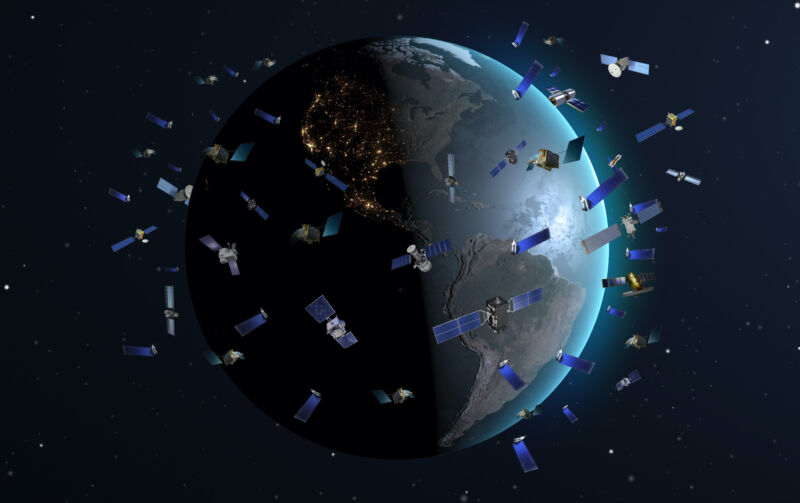Altitude is important
The satellites’ impact on astronomy will be affected by their altitude. Satellites orbiting at altitudes below 600km (like those being launched by SpaceX) are not as harmful to observations as those orbiting above 600km (like those launched by OneWeb). Amazon’s plan calls for altitudes of 590km, 610km, and 630km.
“LEOsat constellations below 600km are visible for a few hours per night around astronomical twilight from observatories at middle latitudes, but they are in Earth’s shadow and invisible for several hours per night around local solar midnight, with some satellites visible during the transitions. This visibility pattern causes these constellations to most heavily impact twilight observers,” the report said.
With sub-600km satellites being closer to the Earth’s surface, they are “brighter than the same satellites would be at higher orbital altitudes” and “more likely to exceed the unaided-eye brightness threshold if operators fail to design with this criterion in mind,” the report said. However, satellites “above 600km are an even greater concern to astronomers because they include all the impacts mentioned above, but can also be illuminated all night long. Full-night illumination causes these high-altitude constellations to impact a larger set of astronomical programs.”
Satellite constellations will be brightest “near the horizon and during twilight,” disproportionately impacting “searches for near-Earth objects (NEOs), distant Solar System objects and optical counterparts of fleeting gravitational wave sources,” the report said, adding:
Depending on constellation design, LEO satellites can also be visible deep into the night, broadening the impact to encompass all astronomical programs. We find that the worst-case constellation designs prove extremely impactful to the most severely affected science programs. For the less affected programs, the impact ranges from negligible to significant, requiring novel software and hardware efforts in an attempt to avoid satellites and remove trails from images.
Satellite constellations like OneWeb’s, with orbits of 1,200km, “present particularly serious challenges; they will be visible all night during summer and significant fractions of the night during winter, fall, and spring, and will have negative impacts on nearly all observational programs,” the report said. (OneWeb, which is going through a bankruptcy and sale, is also using medium-Earth orbits of 8,500km.)
So far, SpaceX has permission to launch nearly 12,000 satellites, OneWeb has approval for 2,000, and Amazon has approval for 3,236. SpaceX has applied to the Federal Communications Commission for another 30,000 satellites and OneWeb has applied for another 47,844.
Action plan
The report listed these methods of minimizing the impact on astronomy:
- Launch fewer or no LEOsat constellations. This is the only option identified that can achieve zero impact.
- Deploy satellites at orbital altitudes no higher than ~600 km.
- Darken satellites by lowering their albedo, shading reflected sunlight, or some combination thereof.
- Control each satellite’s attitude in orbit so that it reflects less sunlight to Earth.
- Remove or mask satellite trails and their effects in images.
- Avoid satellite trails with the use of accurate ephemerides [that provide data about a satellite’s position relative to Earth].
Satellite operators should also “make their best effort to avoid specular reflection (flares) in the direction of observatories.”
The report’s recommendations for observatories focus heavily on development of new software. Observatories should support “development of a software application available to the general astronomy community to identify, model, subtract, and mask satellite trails in images on the basis of user-supplied parameters,” the report said. They should also support development of observation-planning software for “the general astronomy community that predicts the time and projection of satellite transits through an image, given celestial position, time of night, exposure length, and field of view, based on the public database of ephemerides.”
Researchers also provided recommendations for work that observatories and satellite providers can do together, such as “an immediate coordinated effort for optical observations of LEOsat constellation members, to characterize both slowly and rapidly varying reflectivity and the effectiveness of experimental mitigations.”
There’s optimism about the ongoing collaboration. “I hope that the collegiality and spirit of partnership between astronomers and commercial satellite operators will expand to include more members of both communities and that it will continue to prove useful and productive,” NOIRLab director Patrick McCarthy said in a press release. “I also hope that the findings and recommendations in the SATCON1 report will serve as guidelines for observatories and satellite operators alike as we work towards a more detailed understanding of the impacts and mitigations and we learn to share the sky, one of nature’s priceless treasures.”
We’ve provided a summary of the report here, but if you want much more detail on the group’s findings and recommendations, you can check out the report and the lengthy appendices directly.
